The Intel Haswell Refresh Review: Core i7-4790, i5-4690 and i3-4360 Tested
by Ian Cutress on May 11, 2014 3:01 AM ESTReal World Benchmarks
2D to 3D Rendering –Agisoft PhotoScan v1.0: link
Agisoft Photoscan creates 3D models from 2D images, a process which is very computationally expensive. The algorithm is split into four distinct phases, and different phases of the model reconstruction require either fast memory, fast IPC, more cores, or even OpenCL compute devices to hand. Agisoft supplied us with a special version of the software to script the process, where we take 50 images of a stately home and convert it into a medium quality model. This benchmark typically takes around 15-20 minutes on a high end PC on the CPU alone, with GPUs reducing the time.
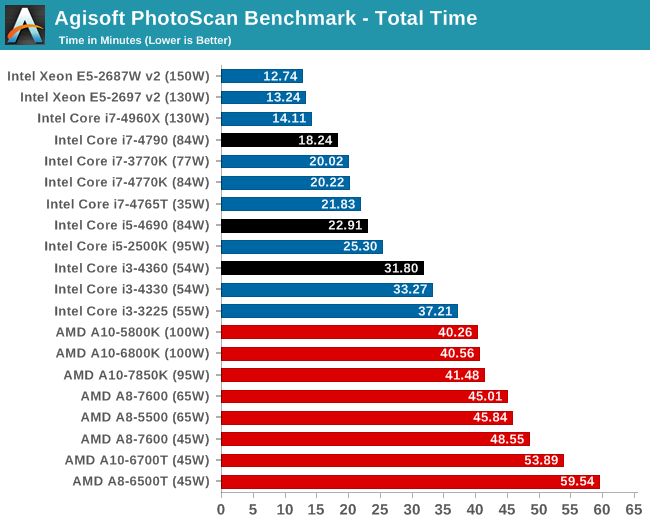
For Photoscan we see the incremental speedup with the i3 models, but the increased single thread speed of the i7 makes more of a difference.
Compression – WinRAR 5.0.1: link
Our WinRAR test from 2013 is updated to the latest version of WinRAR at the start of 2014. We compress a set of 2867 files across 320 folders totaling 1.52 GB in size – 95% of these files are small typical website files, and the rest (90% of the size) are small 30 second 720p videos.
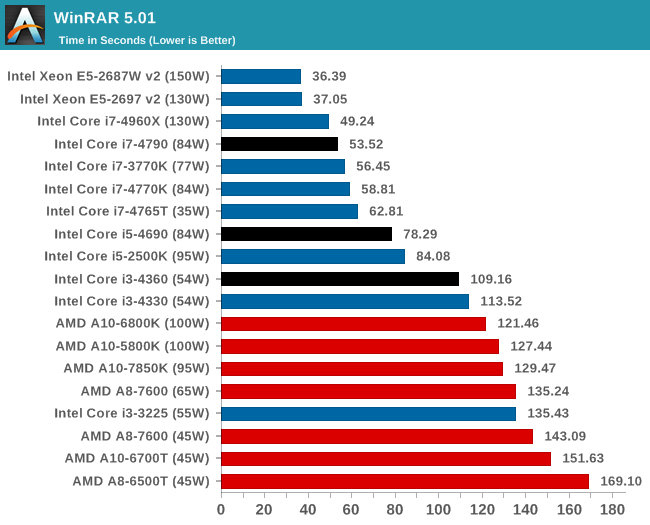
For WinRAR, the increase in the threads makes the most difference here, moving from i5-4690 to i7-4675T.
Image Manipulation – FastStone Image Viewer 4.9: link
Similarly to WinRAR, the FastStone test us updated for 2014 to the latest version. FastStone is the program I use to perform quick or bulk actions on images, such as resizing, adjusting for color and cropping. In our test we take a series of 170 images in various sizes and formats and convert them all into 640x480 .gif files, maintaining the aspect ratio. FastStone does not use multithreading for this test, and thus single threaded performance is often the winner.
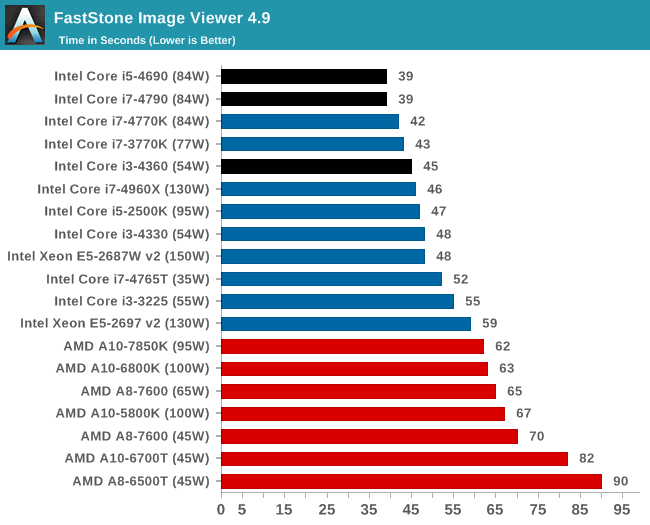
FastStone is all about the single thread speed.
Video Conversion – Xilisoft Video Converter 7: link
The XVC test I normally do is updated to the full version of the software, and this time a different test as well. Here we take two different videos: a double UHD (3840x4320) clip of 10 minutes and a 640x266 DVD rip of a 2h20 film and convert both to iPod suitable formats. The reasoning here is simple – when frames are small enough to fit into memory, the algorithm has more chance to apply work between threads and process the video quicker. Results shown are in seconds and time taken to encode.
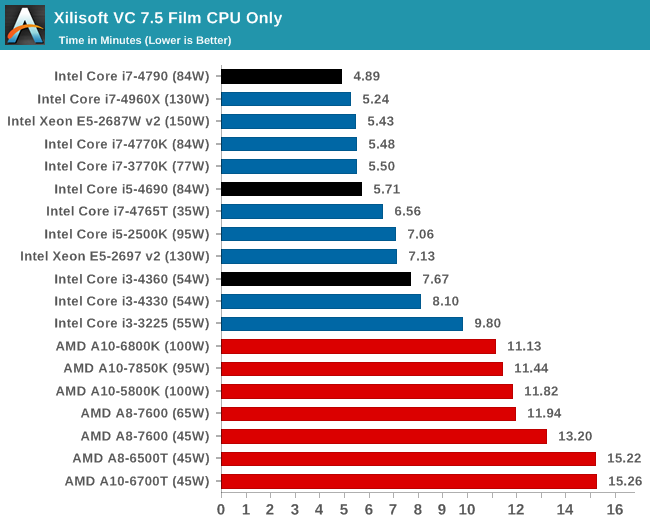
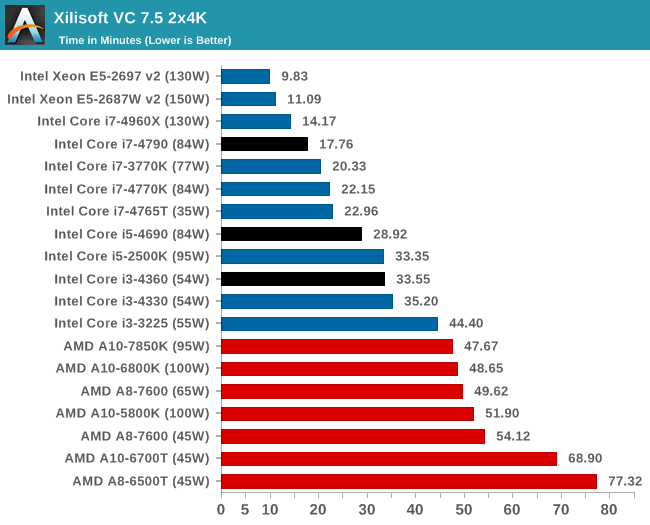
Small frames prefer more single thread MHz, whereas the dual 4K frame conversion prefers threads.
Video Conversion – Handbrake v0.9.9: link
Handbrake is a media conversion tool that was initially designed to help DVD ISOs and Video CDs into more common video formats. The principle today is still the same, primarily as an output for H.264 + AAC/MP3 audio within an MKV container. In our test we use the same videos as in the Xilisoft test, and results are given in frames per second.
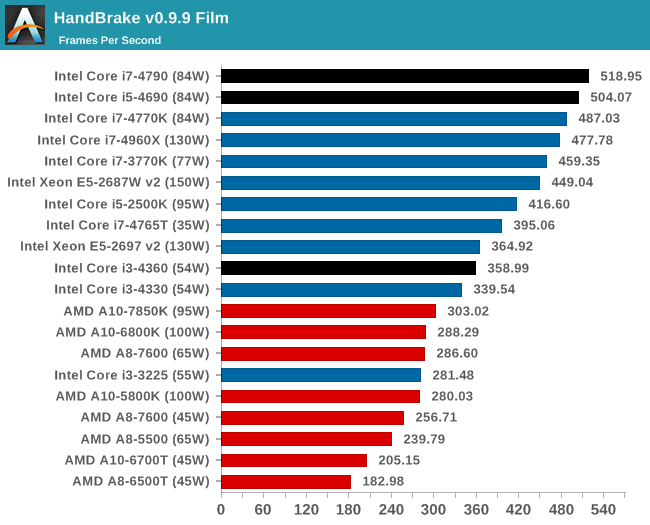
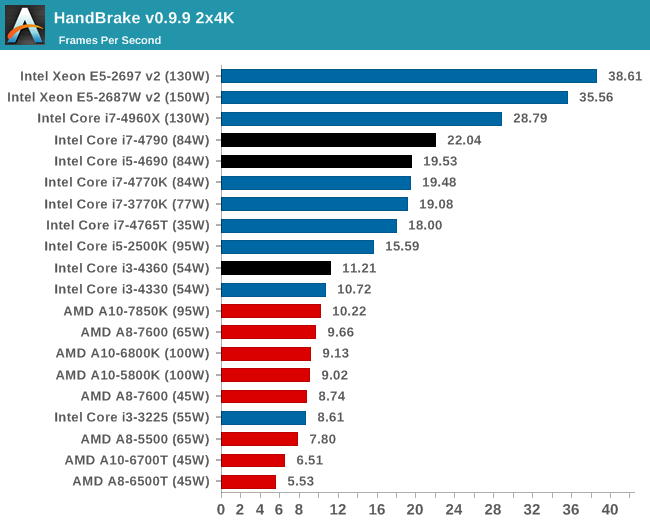
With Handbrake it would seem that it prefers actual cores rather than hyperthreading, given by the i5 and i7 being relatively close and 2x the i3.










130 Comments
View All Comments
stephenbrooks - Saturday, May 24, 2014 - link
I guess in the event that desktops die, I could attach my two 23" screens, keyboard and mouse to a laptop dock instead, because that's more futuristic or something.mikato - Thursday, May 15, 2014 - link
"the limiting factor is the technology between the keyboard and the monitor: the user"Uhh, the user isn't between the keyboard and monitor. The user is on the end of a branch, past the keyboard. Maybe in the future... :)
jayshank7 - Thursday, May 15, 2014 - link
I bought 4770K 2 months back so won't be getting anything before 2016 to be honest.. i may build broadwell based i5 system but my main 4770K based rig would be here with 3 x 280X Toxic for those years..HardwareDufus - Sunday, May 18, 2014 - link
Looking forward to a Broadwell based I7-5790K with IrisPro (HD5200+)Krysto - Wednesday, May 21, 2014 - link
The only reason there's even a "Haswell Refresh" is because Intel blew it with Broadwell, and got delayed by a whole 6 months. In 2015 they will have most of their process advantage, and will be only 6 months ahead of TSMC, once it gets FinFET at 16nm, compared to IVB/Haswell/Silvermont where it had a generation/node and a half advantage.Be Careful - Friday, May 30, 2014 - link
Hey technology nuts I would like you to read this:http://www.jimstonefreelance.com/corevpro.html
deruberhanyok - Monday, June 2, 2014 - link
I might be late to the party, but, on page 9, the bioshock infinite benchmark charts - is the second one mislabeled? The minimum frame rates? It seems to be.duttasanjiv - Thursday, November 13, 2014 - link
Thx for the much elaborate review.I was looking for the Pure CPU performance of i5 4590 in Video encoding, and it unfortunately did not reveal much of the testing procedure. Kindly let us know-
1) What was the Handbrake source(UHD or DVD) & target (Full HD /half HD) frame size ?
2) What was the encoding speed settings (medium? slow?)
3) What was the CRF/ CQF used?
Most imnportantly (for me atleast :-) ) was a comparison in visible quality difference with pure CPU vs Haswell refresh applied. I heard that there is minor quality compromise with Haswell? Did they improve it with Haswell refresh??
GGuess - Saturday, December 6, 2014 - link
There should be a line of discussion of why haven't CPU speeds increased in the past 5years in a significant way. My 5yr old Intel I7 is a 4 core at 3GHz. The ones discussed here are only 6 or 8 cores and run stock in the mid-3 to 4GHz range. So over 5yrs, the CPU capability has not grown 2 to 3times faster, and that only applies to applications that can use the extra cores and hyper-threading. The usual rule we work to is that people won't even notice a 50% speed increase. It has to be 2 to 3 times before it is noticed. Previously, a 3year refresh of a computer resulted in a 5 to 10x computer speed increase.With the current barely noticeable 2x, why bother with the trouble of an upgrade? No wonder Intel's and AMD's sales figures are failing to grow.
johnny_boy - Friday, February 27, 2015 - link
Why are all the AMD chips APUs? Why not throw at least one top-end FX processor into the mix, like the very common FX-8350 which costs about as much as a 4360.